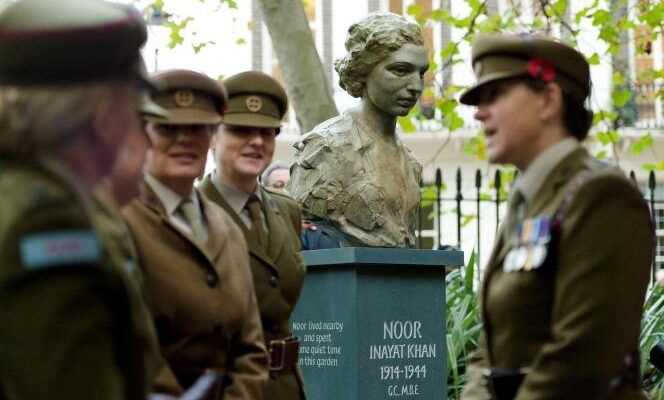Owhere are the women? From Washington in Paris by the way by India, their under-representation in the public space no longer needs to be demonstrated. But London is the first city to take the measure. Unsurprisingly, a study published on October 21 by the British cultural organization UK Art revealed that the vast majority of the approximately 1,100 statues adorning the public space of the capital of the United Kingdom were dedicated to men. More surprising, however, while around fifty of them pay homage to famous women, nearly double – 8% – are devoted … to animals. People of color represent only 1% of the sculptures in the megalopolis, and women of color 0.2%.
Get to know the art of the capital ✨ With over 1,100 of # London’s public sculptures on Art UK, we reveal some of… https://t.co/fwlPGaa1Rg
Under-represented women
For the past four years, Art UK has been working to compile an inventory of London statues as part of a large research project, funded in part by Labor City Hall. “These are the men who made history. (…) Women’s achievements were made invisible even though they did incredible things ”, explained in 2017, in an interview at the site Equaltimes.org, Bee Rowlatt, author and chair of a campaign to pay tribute to Mary Wollstonecraft, one of the pioneers of English feminism.
Terri Bell-Halliwell, founder ofinVISIBLEwomen, an organization which militates for the equality of representation of the sexes in the public space, saw in it a subliminal mark of the patriarchy “Convincing us all that only men are worth admiring”. All the more so, she adds, since this lack of representation of deserving female models makes women and girls feel “Marginalized and little recognized”.
According to inVISIBLEwomen statistics, the statues of men are sixteen times more numerous than those of women: “And if we excluded Queen Victoria from the equation, the numbers would be much worse. “ In 2020, the Public Statues and Sculpture Association began listing all statues of women, except members of the royal family. For now, she has only counted 119 statues of women in the UK.
In the wake of the Black Lives Matter movement (“black lives matter”) and the death of African-American George Floyd at the end of May 2020, questioning and introspection have spread in the United Kingdom around the country’s colonial past and its representation in the public space. In June 2020, in Bristol, protesters debunked the statue of Edward Colston, a 17th century slave tradere century, and threw it into the River Avon.
Improve diversity
It is in this context of tension that the Mayor of London, Sadiq Khan, announced in February 2021 the creation of a commission for diversity in the public domain. The latter has an envelope of one million pounds sterling (approximately 1.182 million euros) to create new monuments that “Better reflect the diversity of the capital and the achievements of all those who have contributed to the success of the city”.
But for the conservative Jacob Rees-Mogg, the leader of the House of Commons – the minister responsible for relations with the House of Commons within the government – this commission is nothing but a collected from “Crazy leftists” and determined to destroy local heritage. What does it matter if Aindrea Emelife, art historian of 27, one of the members of the commission, had insisted on the daily The Guardian : “There is no question of cutting down statues. “
Still, even when it comes to celebrating women, London has long been conservative. The capital has certainly evolved by honoring Mary Seacole, a Jamaican-Scottish nurse known for her personal commitment during the Crimean War and one of the few women of color to have a statue, or Noor Inayat Khan, a Muslim from Indian origin sent on mission to France by the SOE (Special Operations Executive, a branch of the British secret services during the Second World War). Captured, she was executed in the Dachau concentration camp.
Since 2008, a bust of Violette Szabo, a French resistance officer, SOE agent, has been outside Lambeth Palace, opposite the Palace of Westminster. In 2014, three years after the singer’s death, a statue ofAmy winehouse was inaugurated in Camden Market in the presence of her parents.
Paris too is trying to catch up
On the other side of the Channel, the situation is no better. Paris has several hundred statues erected in public spaces, mostly representing male figures.
For a Berty Albrecht, one of the six female companions of the Liberation, or a Maryse Bastié, a French aviator, most of the fifty or so illustrious women represented in the capital are made up of historical figures – five Joan of Arc, two Saint Geneviève -, mythological and allegorical figures – like the Republic or Justice – or George Sand, Sarah Bernhardt, Edith Piaf and Dalida.
Like London, Paris intends to do justice to forgotten women: on September 26, 2020, the socialist mayor, Anne Hidalgo, inaugurated a garden in tribute to Solitude, historical heroine of the resistance of the slaves, who fought against the reestablishment of the slavery in Guadeloupe at the end of the 18th centurye century. A statue should follow: the first paying homage to a black woman.
